Getting your blog post on the first page of Google is what everybody blogger hopes for. But with 2,000,000 blog posts published every day, it’s not easy.
The competiton is intense – everyone wants those top 10 spots. So how do you do it?
Well, there’s a way of creating content that dramatically increases your chances of getting on Page #1 of Google.
And that’s what I’m going to show you in this article.
Let’s get started!

Backlinks vs Topical Authority
It used to be that backlinks were the only way to rank on Page #1 of Google. But more and more sites are managing to rank at the top of the search results on the basis of topical authority alone.
Backlinks
Backlinks measure what humans think of a web page: the more backlinks a web page has, the more likely it is that the page is a valuable resource.
But search engines are now able to make their own assessment of how valuable a web page is. And that means that backlinks are no longer as important as they used to be in ranking your content on the first page of Google.
Topical authority
Before the Hummingbird algorithm, search engines couldn’t read or understand content. So they relied on backlinks to rank web pages. The more backlinks a page had, the more relevant it must be.
But with Latent Semantic Indexing (LSI) and the Hummingbird algorithm that’s all changing. Through machine learning, AI, and the BERT algorithm, search engines can now understand context much better.
This means that search engines are now able to measure how authoritative a piece of content is, based on an analysis of the content itself.
What does this mean for ranking on the first page of Google?
It means that even if you have relatively few backlinks, you can still rank on Page #1 of Google if your content covers a topic well in both depth and breadth.
It’s important to understand that search engines measure topical authority not just for individual blog posts, but also for your website as a whole.
And that’s why the first step in ranking an individual blog post is to look at the topical authority of your website as a whole.
How To Rank on the First Page of Google
STEP #1 – Find your website’s topical authority
Go to your Google Analytics account and click through to Behavior > Site Content > All Pages:
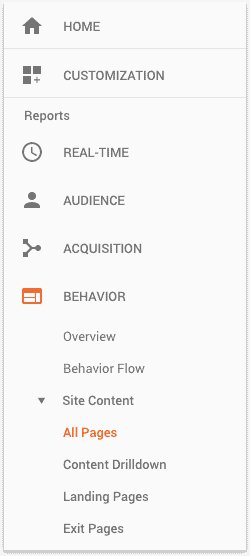
You’ll see a list your most popular blog posts:
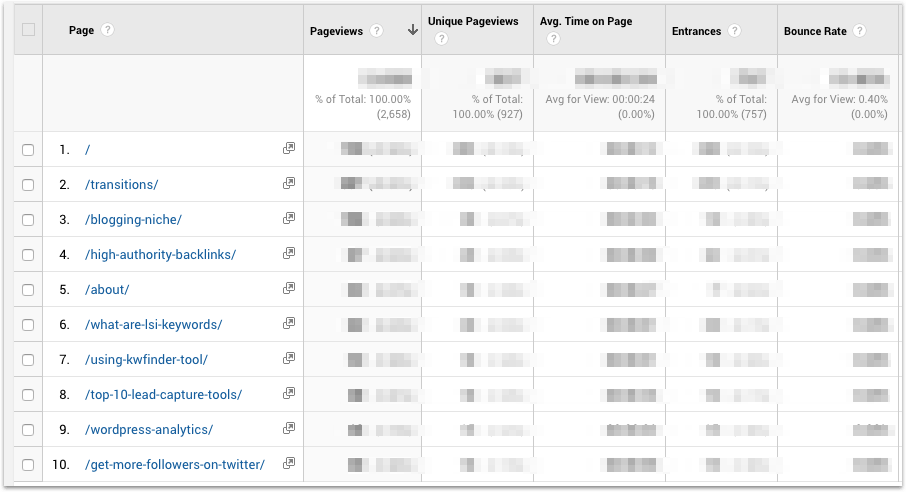
Cast your eye down the first column (‘Page’) and look for a pattern in the pages that rank highest.
Is there a sub-topic that your most popular blog posts have in common?
Let’s say your blog is about ‘fitness’. Maybe you notice that your most popular blog posts are all to do with ‘fasting’?
That’s where your topical authority is!
The Google algorithm has analyzed your content and decided that you cover the topic of ‘fasting’ better and more comprehensively than most other websites.
The topical authority that Google has given you for ‘fasting’ is resulting in high rankings for your blog posts on that topic.
That’s information you can leverage!
Write blog posts on that specific topic and you know you’re going to have a very good chance of getting on the first page of Google.
STEP #2 – Research your topic
In this step, you need to look at the content that is currently ranking on Google for your target keyword.
Let’s say you want to write an article about organizing a wedding
Go to Google and type in ‘how to organize a wedding’:
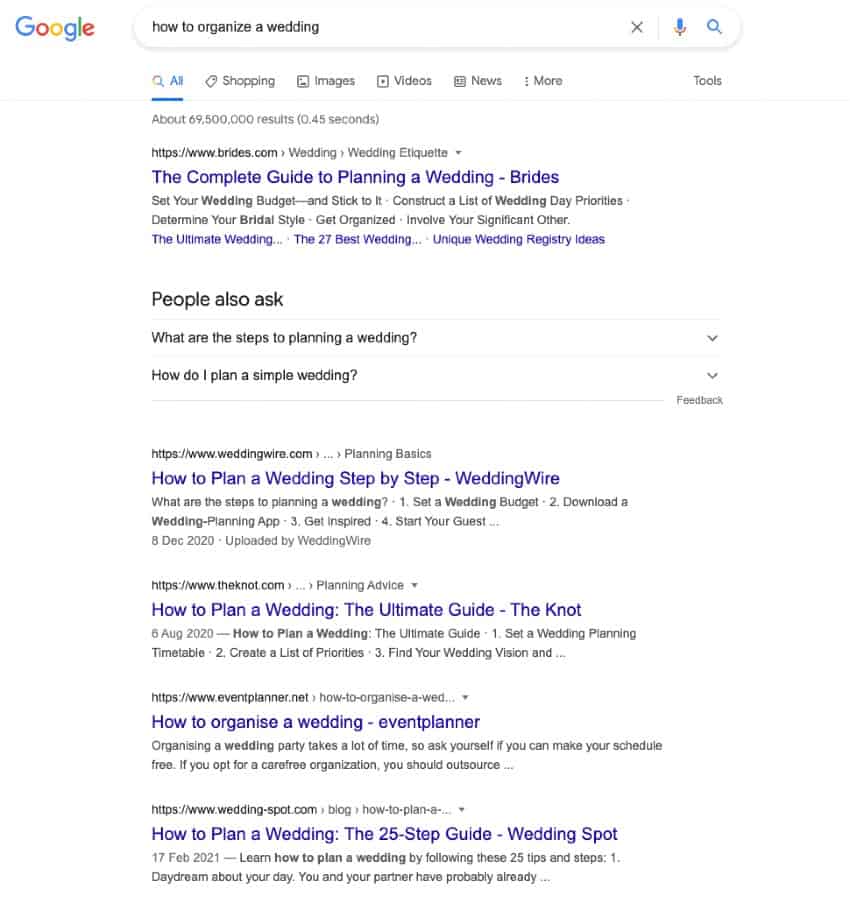
Look for topics and subtopics
Find the top five blog posts that are listed by Google.
Scan through them and look for headings, sub-headings, and bullet points.
There’s no need to read the entire article at this stage. All you want is a list of the sub-topics covered by each blog post.
Lets say:
- article #1 has 6 sub-topics
- article #2 has 3 sub-topics
- article #3 has 5 sub-topics
- article #4 has 3 sub-topics
- article #5 has 2 sub-topics
In this scenario, you would write an article with 19 sub-topics.
Of course, this is oversimplified because there’ll be a lot of overlap between the 5 articles, (as shown in the diagram below):
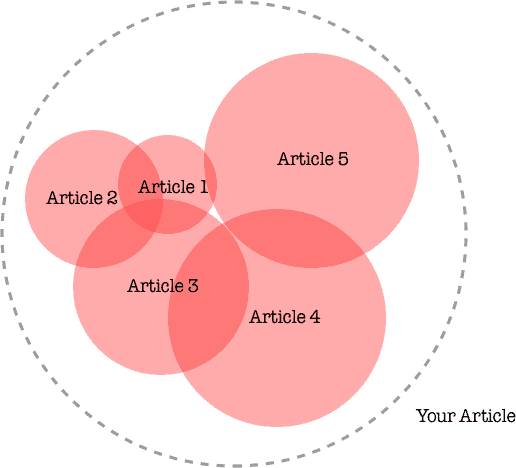
Due to overlap, there may only be 10 separate subtopics amongst those 5 articles.
Once you have a list of the subtopics for your blog post, it’s time to do the second round of research.
This time you’re going to research the sub-topics rather than the main topic.
Research the subtopics
Go to Google and type in, one by one, those ten subtopics. Research each subtopic by scanning though the top 3 blog posts for each subtopic.
Once you’ve finished the second round of research, just write 100 to 200 words on each subtopic.
Always find a way to express the information or ideas in your own words – never copy and paste someone else’s writing, as that belongs to them.
If an idea is original or an article contains original research, always link to the source article and mention the blogger by name.
STEP #3 – Do some On-Page SEO
Once you’ve written your article, the next step is to optimize all the relevant on-page SEO factors.
The easiest way to do this is simply install the free RankMath SEO plugin for WordPress and follow the recommendations until you get a ‘green’ score:
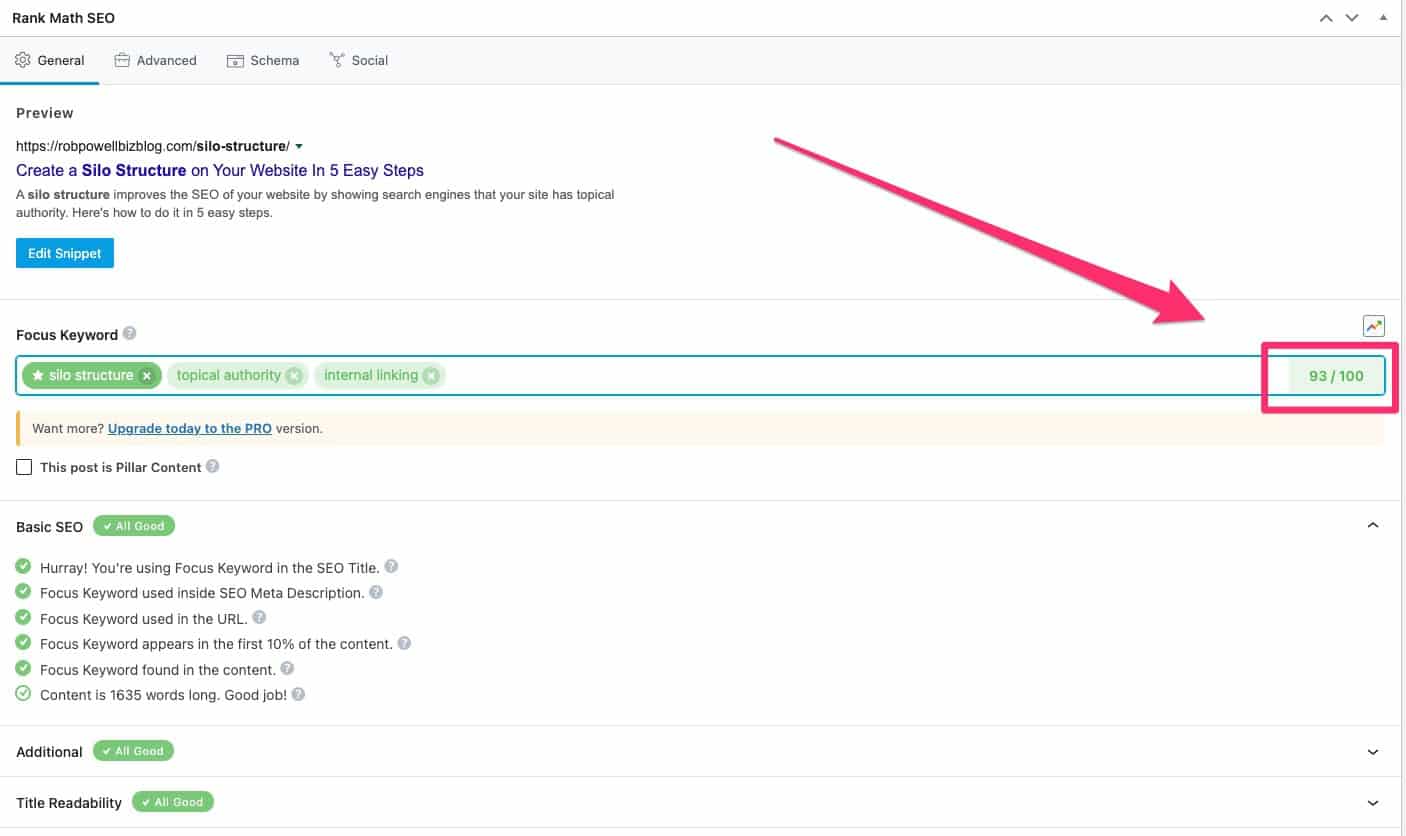
STEP #4 – Add semantically related keywords
When you’re trying to get on the first page of Google for a particular keyword phrase, one thing you need to think about is “what are the other keywords that are typically found alongside my focus keyword?”
The idea here is that any particular keyword will have a cluster of semantically related keywords that are often found in association with that particular keyword.
If your page contains your focus keyword but none of the LSI keywords typically associated with that keyword, the algorithm will conclude that your piece of content doesn’t cover the topic very well.
So if you want to get on the first page of Google, it’s important to include on your page as many semantically related keywords as you can. These are words that are often found in association with your main keyword.
To find these semantically-related keywords, type your main keyword into Google Search and then have a look at these three areas within Google Search:
- Google Auto Suggest
- People Also Ask
- Related Searches
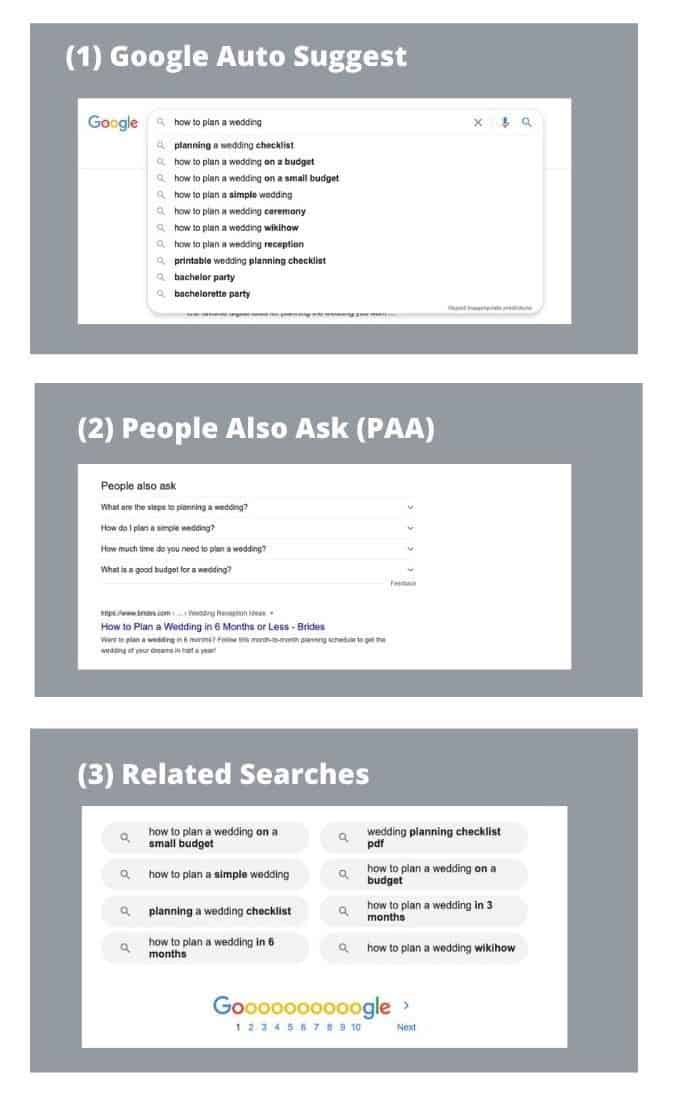
STEP #5 – Get your page indexed
The last step in getting your blog post on the first page of Google is to ask Google to crawl your page.
Log into your Google Search Console (formerly known as ‘Google Webmaster Tools’).
In the left hand navigation, click on Crawl > Fetch as Google:
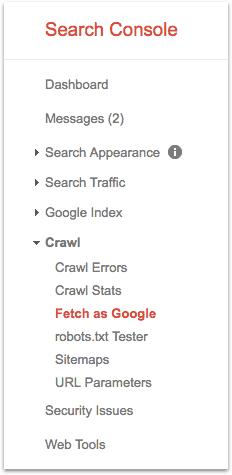
In the right panel, enter the slug of your blog post and then click on ‘Fetch’:

Once you’ve done that, Google will prompt you to request indexing of your web page:

Click on the ‘Request Indexing’ button and a window will pop up asking you to verify that you’re not a robot:
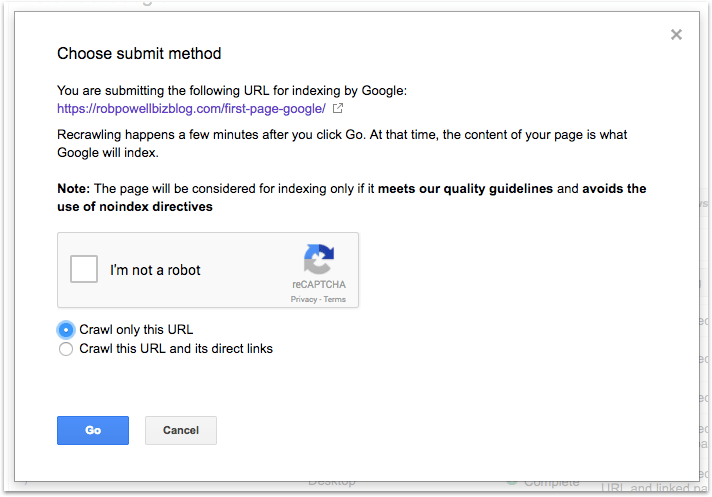
Check the box for ‘Crawl only this URL’ and then click the reCAPTCHA button.
The status on your web page will now change to ‘Indexing requested’:
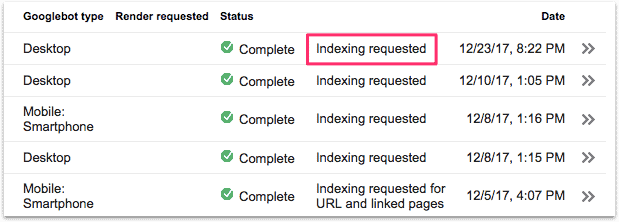
That’s all you need to do!
In SEO, there are never any guarantees. But if you follow this approach, you’ll have a better than average chance of ranking on Page #1.
Conclusion
Backlinks from relevant authority sites are still a big factor in getting your pages ranked on the first page of Google. But even if you have a fairly weak backlink profile, you can still appear on Page #1 of Google and outrank sites with many more backlinks.
The way to do this is to examine the topics and subtopics in the top-ranking articles and make sure that your article covers those topics better.
Hey Rob – First of all, love your site! Lots of great info and allows take the time to read your newsletter. Keep up the great work. My question is related to semantically related keywords. In your “bitcoin” example, I’m confused on how to use these related keywords. When using them in a post, do we need to use the root word with the related word each time we use it or do we need to use the root word and semantically related keywords separately?
This is an epic article Rob! I had hears about the skyscraper technique, but this goes way beyond that. I also love how you use pics along the way to show the process, Neil Patel is huge on this as well. Your blog has climbed fast in the last year – way to go!
Hi Rick – Thanks for your feedback. Thats a good question. The semantically related keywords need to be sprinkled around the article. You definitely wouldn’t want to use the LSI keywords every time you use the main keyword. And of course, only use LSI keywords that fit naturally with the topics you are covering with your article. You can think of the LSI keywords as representing all of the sub-topics associated with the main topic. To achieve high topical authority (and hopefully get a page #1 ranking) you need to cover as many of the sub-topics associated with that main topic as you can. Hope this helps 🙂 Rob.
Hi Erik, great to see you here, and thanks for the feedback! All the best, Rob.
I have a status blog. I have posted in this also. But they do not rank in Google, while I have done the keyword and also indexed them in Google search.
The smaller posts of others are also ranked. How do i please tell
Hi Pramod, it’s difficult to know exactly what the problem is from the information you gave in your comment. SEO is quite complex, it has a lot of ‘moving parts’. To get on Page #1 of Google these are key factors that you would need to address: 1) your blog post needs to be at least 2000 words in length, 2) you need to install the free version of Yoast SEO and make sure all the SEO indicators are turned to ‘green’ (ie you have met Yoast’s SEO requirements), 3) you need to choose a long tail keyword (the short tail keywords or ‘main keywords’ or ‘head keywords’ have insane levels of competition), 4) you need to find long tail keywords with low competition. To do that you will need to pay for a keyword research tool. The one I use and highly recommend is KWfinder. Hope this helps 🙂 Rob.
Thank you so much..will definately follow these tips to rank on google.
One again, Rob Powell, thank you so much for this amazing article.
Thank you so much for this amazing article Rob. Will definately use the techniques you have given.
Hey,Rob Powell
I Need Your Help, All SEO Techniques Used for my website ranked on google but no response … Please Suggest me.
Hi Atma, you’re most welcome. Thanks for dropping by 🙂 Rob
You’re most welcome, thanks for the comment :), Rob.
Hi Himani, can you explain a bit more what the problem is? I’ll see if I can help. Best, Rob.
You’re welcome 🙂
Hay Rob Powell Would you please tell us how to write the best title and description.
Hey Rupesh, thanks for your request 🙂 My next post will be on how to write effective blog post titles. I’ll write a separate post on how to write effective meta descriptions. Thanks for the suggestion! Best regards, Rob.
This is superb. My articles have mostly been making it to page 2 and I will use your tips to try and get to page 1. Thanks
Hi John,
Thanks so much for your comment. I’m glad it was useful. All the best with your SEO!
Rob
This is an interesting post. I have never considered this aspect while ranking content for websites. The right choice of keywords can actually make a big difference. Thank you for sharing this post and elaborating on the nuances related to SEO. Keep penning such posts and insights.
Hi Rihaan, thanks for your comment. I’m glad the article was useful. All the best with your content! – Rob
Being on first page this days takes a lot of time and effort and to be on the first page it needs a lot of link building and writing original content not less than 500 words and just don’t wait to rank, keep writing new quality post every other day, thats how to rank a page.
Hi Paul, thanks for your comment. Backlinks are certainly a big part of it (getting on Page #1). But so also is Topical Authority and User Experience (RankBrain). To increase your topical authority, see this article of mine: How To Find Seed Keywords In Your Niche & Increase Topical Authority. Best, Rob.
Hii,
Thanks for Putting this amazing article. I have recently made a post about Google Algorthims, can you help me to rank higher!
Hi Soubhagya, thanks for your comment! I’m currently working on a new video course that teaches how to get your blog posts on Page #1 of Google. If you like, I can let you know as it’s released. All the best, Rob.
Hello sir,
what can I do if my bounce back rate is increased?
https://goo.gl/qT83Pa
Hi Sagar,
Thanks for your question.
These would be my top suggestions for reducing bounce rate on your web page:
1. Speed up your web page loading time – about half of your visitors expect a web page to load within 2 seconds
2. Create valuable content that matches the targeted keyword
3. Use the target keyword in the first paragraph – when your visitors see their search query keyword in the first paragraph, they’re more likely to stay on your page
4. Consider including a Table of Contents so readers can see at a glance what topics your article addresses
Hope this helps,
Rob.
Hey Rob thank you so much for write such a nice article about seo, i am a new blogger i just created my blog on google blogger can you tell me what is best blogging plat form google blogger or wordprees?
Hi Prosanta,
Thanks for your question.
I would definitely choose WordPress over Blogger. Here are the main reasons you should go with WP:
1. With Google Blogger, you don’t own your site – Google does. Ultimately, your site’s continued existence depends on Google. They could decide to ‘retire’ Blogger tomorrow and you would lose your blog site. With a self-hosted WP site, you own it: no one can ever take it away from you.
2. Blogger has very limited functionality compared with WordPress. By contrast, there are 1000’s of WordPress plugins that extend the functionality of the WP platform.
3. With Blogger, you have very limited options for customizing the appearance of your website. By contrast, there are thousands of free and paid WP themes that allow you to customize the appearance of your site.
Hope this helps!
Rob.
Sir why my site do not have traffic ??/ plz answer
https://mdshakilhossen.com/
Hi Shakil,
It’s difficult to answer that question without knowing what promotion techniques you have been using.
However, I can see one reason you might be having trouble getting traffic: your blog appears not to have a focus. I can see blog posts on health and lifestyle as well as blog posts on technology. Without a very well-defined focus, it’s difficult to build traffic to a blog.
This article explains why a well-defined niche is so important: How To Find a Blogging Niche in 2019 – The Beginner’s Guide.
I hope this helps, Rob.
my opinion, SEO is very complicated …
If you produce well-researched and well-written articles, most of the SEO factors will already be taken care of. When seen from the perspective, it’s not that complicated 🙂 Rob.
You write a good article,
How to article rank in google??
If you have any such post please send me the need. ..
Hi Anil,
Thanks for your feedback and your question.
Here is a blog post I wrote about how to get ranked on Google: How To Write Blog Posts That Rank In Google In 10 Key Steps
I hope it helps,
Rob.
Great advices, i’ll follow the steps to optimize my website ranking, i was struggling a lot to get at leats at the second or third page lol
Hi Brad,
Thanks for your comment. All the best with your ranking.
Rob.
Nice article, thanks for sharing .Gonna implement it on my new site
Thanks, Ezekwe, I’m glad it was useful, Rob.
Can you check my site and tell me what is work in my site please
wow i really love this article.
now i know exactly where i’m getting it wrong in ranking well on good.
Thank you very much.
Hey Johnny, thanks for your comment. I’m so glad the article was helpful. Every success, Rob.
How many words article help to SERP on number 1 position?
Hi John,
Thanks for your question. Backlinko found that the average word length of articles on Page #1 of Google is 1,890 words. So I would aim for about 2000 words.
Cheers, Rob.
Thank You So Much Sir For Writing This Great Post I Am Looking For Some Valuable Tips And Then I Found Your Website And Sir I Have One Question In My Mind Is It Good To Only Focus On Long Tail Keyword I Am Looking For Your Answer Thanks.
HI, I AM REALLY GOING TO USE YOUR TIPS NOW. THANKS FOR YOUR INFO. I WILL GET BACK TO YOU IF ANY PROBLEM WILL OCCUR OR ANYTHING NOT CLEAR.
Thanks, Awais, all the best with your blogging, Rob.
Hi Zaid,
Thanks for your question. Yes, definitely. You should focus only on long tail keywords. They are the only keywords that most bloggers will be able to rank for on Google.
All the best 🙂
Rob.
Thanks for the guide sir,after implementing this rule I was able to level up my ranking than I have expected it to improve
Hi Oladoke, thanks for sharing that. I’m glad it helped you increase your ranking. All the best – Rob
Hi rob, ?I was doing google search based on keyword ‘free website submission to search engines’ and your blog came top #10. I’ve found that I didn’t get the exact info I needed from those blogs above you. I’m so glad to have read your thorough explanation of tips to getting more real traffics to my website. Obviously I’ve learned something new about the sub topics. Thanks Rob ?
Hi Tuty,
Wonderful feedback! I’m really glad it was useful and helped you understand the topic.
All the best 🙂
Rob.
Wow…This helped me a lot.. I came back to say Thank you for the nice article… I applied it and it worked.. Thanks
Hi Johnny, I’m really glad the article was helpful. All the best with your blogging – Rob
Hi Aminat,
Thanks for your question.
I’m assuming you’re on the WordPress platform. If that’s the case, the easiest way to connect your website with GSC is by using the free Yoast SEO plugin. Here is a video that explains how to do it: https://youtu.be/-l6733dDx9Q
Let me know if you still have problems.
Best regards,
Rob
Thanks for your feedback, Alex. All the best with your SEO – Rob
Hi,
I’ve applied this strategy to one of my old blog post that wasn’t improving in rankings. It was stuck at page 5 or 6 since 3 months but now it is on page 2. I hope it will hit the page 1 soon.
Thank for sharing.
Awesome! Thanks for sharing that, Rajan. I’m thrilled when people get results from my articles! Keep going strong – Rob
Can you review my site and help me to get on the 1st page of google.
Excellent read, helped a lot!
Thanks, Vicky, glad it was useful – Rob.
Excellent article, and lots of useful tips! I think the big G has done away with “fetch as google” as I no longer see it listed in search console. And I’ve read a few blogs that say they can’t find it either. Have you experienced this yet? Thanks and keep up the good work!
Hi James,
Thanks for your feedback.
You’re quite – ‘fetch as Google’ no longer exists in the new Google Search Console. But the function is still there.
In the address bar at the top of the new GSC, you’ll see a field with the words: “Inspect any URL”.
Just paste in the URL of your new blog post. Google will then examine it and if that URL is not in its index, Google will ask if you want it indexed. Click ‘Yes’ (or whatever the button says – I forgotten the exact wording) and Google will place that URL on a priority list for indexing.
All the best!
Rob.
Hi Sir, I want to see my blog in google first page? How can u help me? Please really appreciate if u help me. Thanks.
Hi Leong, I have a course called ‘Page #1 Traffic Surge‘ that shows you how I get my articles on Page #1 of Google. Hope this helps, Rob.